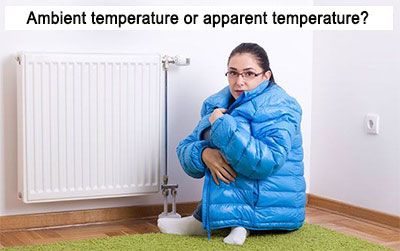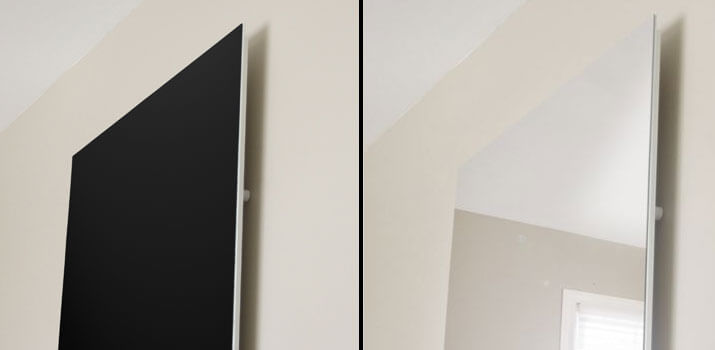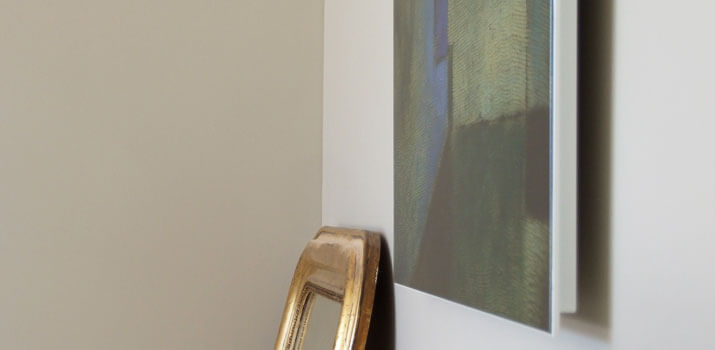Home / Heating / Infrared Heating / How to increase the apparent temperature in a heated room without increasing the bill? (español – français)
How to increase the apparent temperature in a heated room without increasing the bill?
Share this page
What is the apparent temperature?
The apparent temperature on the outside: a matter of sensations…
Commonly, we talk about the apparent temperature in the midst of winter or summer. Indeed, the bigger the difference between the temperature of our body and the external temperature, the more the heat flow (quantity of heat escaping from our body towards the environment) increases. As a result, the unpleasant sensations (too hot, too cold) are “felt” as amplified. External factors as the wind or the humidity amplify this phenomenon. In winter the wind factor “deprives” our body from the radiation it emits constantly to warm us up (we burn more calories to keep it at 37°C). In summer, the humidity factor, prevents our body to evacuate effectively its sweat. So the higher is the humidity, the more the sensation is unpleasant.
What are the physical factors influencing the thermal comfort in a building (in terms of heating)?
- The ambient air temperature Ta (the lower it is, the greater the thermal flows are, the greater the sensation of cold is)
- The variation of temperature (more or less significant) over time (heat waves) and space (temperature gradient between the floor and the ceiling, which means the none homogeneity of the temperature, we talk about stratification: 27°C under the ceiling and 12°C on the floor). This variation and this discomfort are related to the heating mode used and to the asymmetry of the radiation of different walls (glazings, walls, ceiling, floor) which should not be greater than 10°C (ISO 7730:2005 ergonomics of thermal environment).
- The average wall temperature Tw (glazings, walls, floor, ceiling) and the difference relative to the ambient temperature. This difference should be as limited as possible.
- The air circulation velocity in the room (preferably lower than 0,2 m/s).
- The relative air humidity (preferably between 40 and 60%).
Differences between the measured temperature and the apparent temperature
Empirically the apparent temperature is said to be the average between the ambient temperature and the “radiant” temperature of the walls.
Of course, the emissivity (by radiation) of the materials constituting the walls will have a significant influence on the apparent temperature. For example, at a temperature of 15°C, a glazing or a concrete wall will emit a cold radiation far more unpleasant than an earthen wall or a wall covered with wood sheathing. Also the effusivity of the material, which characterises its capacity to heat up more or less quickly on the surface, will influence the reaction of the wall facing the heating. An insulating heats up quickly on the surface without letting the energy passing through.

Thus, a room where the ambient temperature is 22°C but the average wall temperature is 15°C would result in an apparent temperature of 18.5°C (22°C+15°C/2), which would not be satisfactory in terms of comfort (whereas the room would be overheated)!
Consequently, and contrary to popular belief, increasing the ambient temperature of a room hoping to achieve the desired comfort is a poor solution in most of the cases. Especially when each additional degree costs you 7% more in additional energy.

How to measure or evaluate the apparent temperature?
Measure the apparent temperature not the ambient temperature!
- Simplified method 1:
- In order to measure the wall temperature, the most simple is to have an ordinary infrared thermometer. Measure the surface temperature of all 4 walls, the ceiling, the floor, and each glazing then perform an overall average of the room. Pay attention not to have a difference bigger than 10°C between the hottest and the coldest wall.
- Compare the average obtained (T wall) to the value of your ambient thermostat (see the ideal positioning of a thermostat). Refer to the following paragraph to evaluate the difference (and therefore the comfort) depending on your insulation level.
- Methode 2: the temperature felt by the human body (or resulting temperature) is the average between the air temperature and the average wall temperature of the room (mean radiant temperature – MRT). For example: Temperature of all walls (walls, floor, ceiling) = average T of walls = 17°C and air Temperature Tair = 22°C. The apparent temperature in the middle of the room will be 19.5°C ((17°C+22°C)/2).
- Methode 3: there are also mobile test rigs, reserved for professional use. Measuring devices, which operating principal is based on spherical sensors (called black ball temperature probe to measure the WBGT). This probe device measures directly the flow of thermal radiation that it receives.
What kind of solutions to increase the apparent temperature, therefore the comfort?
A good insulation is the first rule!
The comfort range depends directly on the relationship between the wall temperature, the ambient temperature (of the air) and the quality of wall insulation (in order to limit heat losses).

Experience tells us that the better the wall insulation (walls, ceiling, floor) is, the less significant the ambient temperature (therefore the heating), to reach a good level of comfort, will be.

Specifically, according to the literature, the expert measurements affirm that:
- for a good insulation level (U=0.2w/m2.K), an ambient temperature and a wall temperature of 19°C will result in an excellent comfort.
- for an average insulation level (U=1.0w/m2.K), an ambient temperature of at least 21°C and a wall temperature of 17°C are the conditions required to reach the comfort zone.
- for a poor insulation level (U=1.5w/m2.K), an ambient temperature of at least 23°C and a wall temperature of 16°C are the conditions required to reach the comfort zone.
How to increase the apparent temperature without increasing the ambient temperature (and the heating)?
- Improve the insulation of the room (ceiling, floor, walls) while taking advantage of external caloric intake (orientation in relation to the sun).
- Improve the airtightness.
- Glazings: use curtains or draperies (and even thermal curtains or insulating curtains) or close the shutters to limit the radiation of the glazing walls towards you.
- Install infrared heaters to heat the masses.
The infrared heating can increase the apparent temperature without increasing the energy consumption
Based on physical principal that any body (which temperature is above absolute 0) will emit energy through radiation, the radiant heating will emit infrared radiation towards the bodies and the walls (floor, wall, ceiling, etc.). This energy will be accumulated in the building structure, to be then radiated on its turn inwardly in the room. The effectiveness of this phenomenon lies in the fact that the wall temperature will increase contrarily to a conventional convection heating.


FOX2




